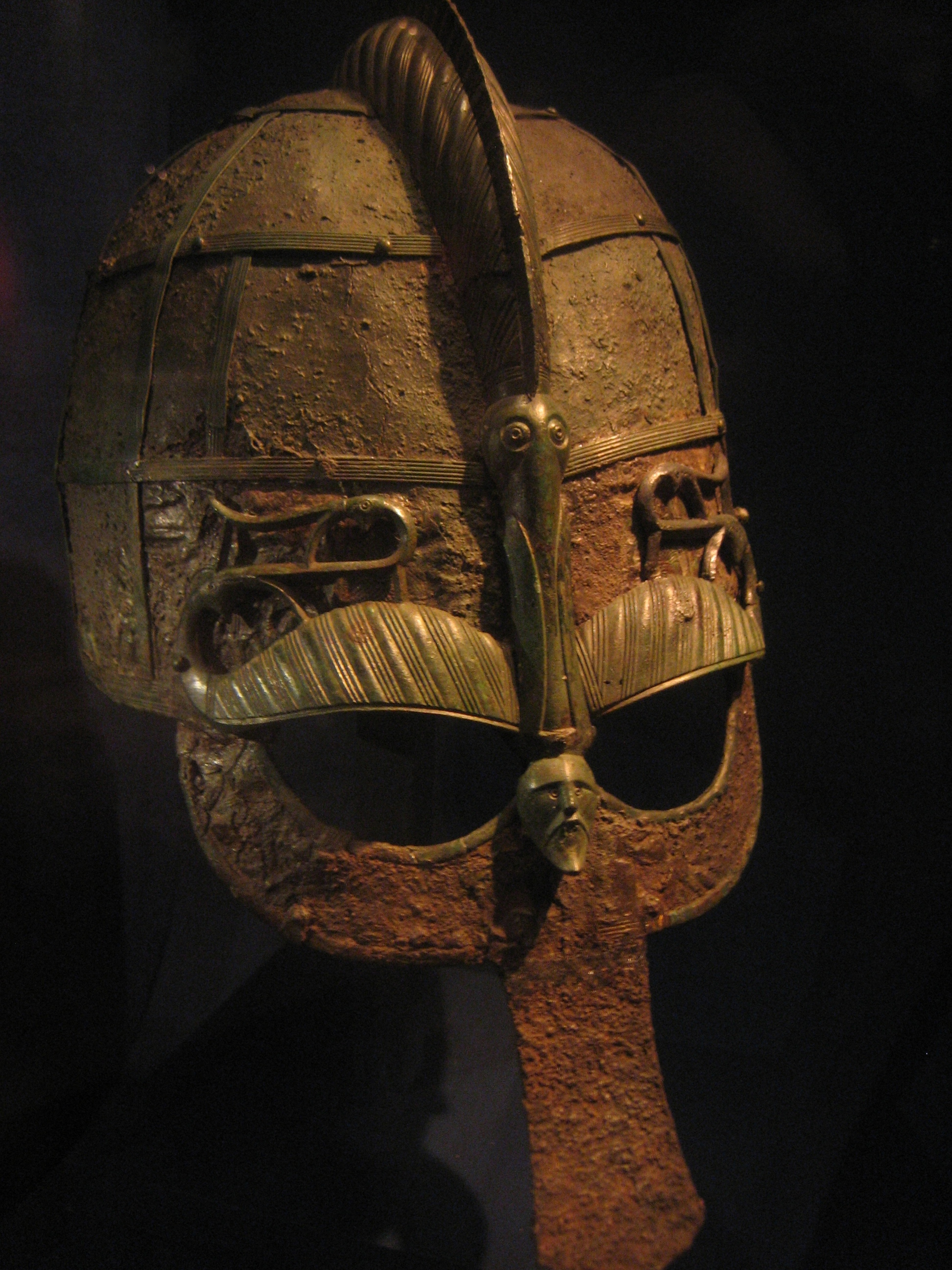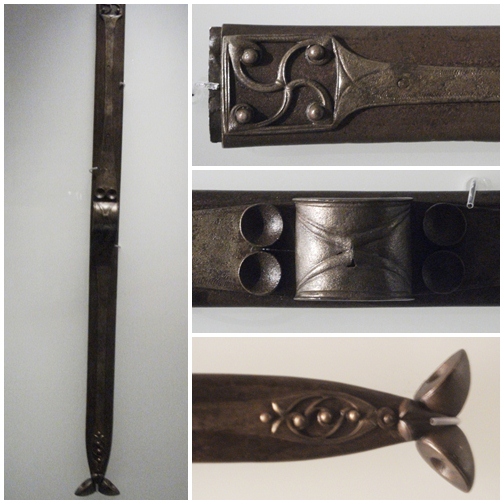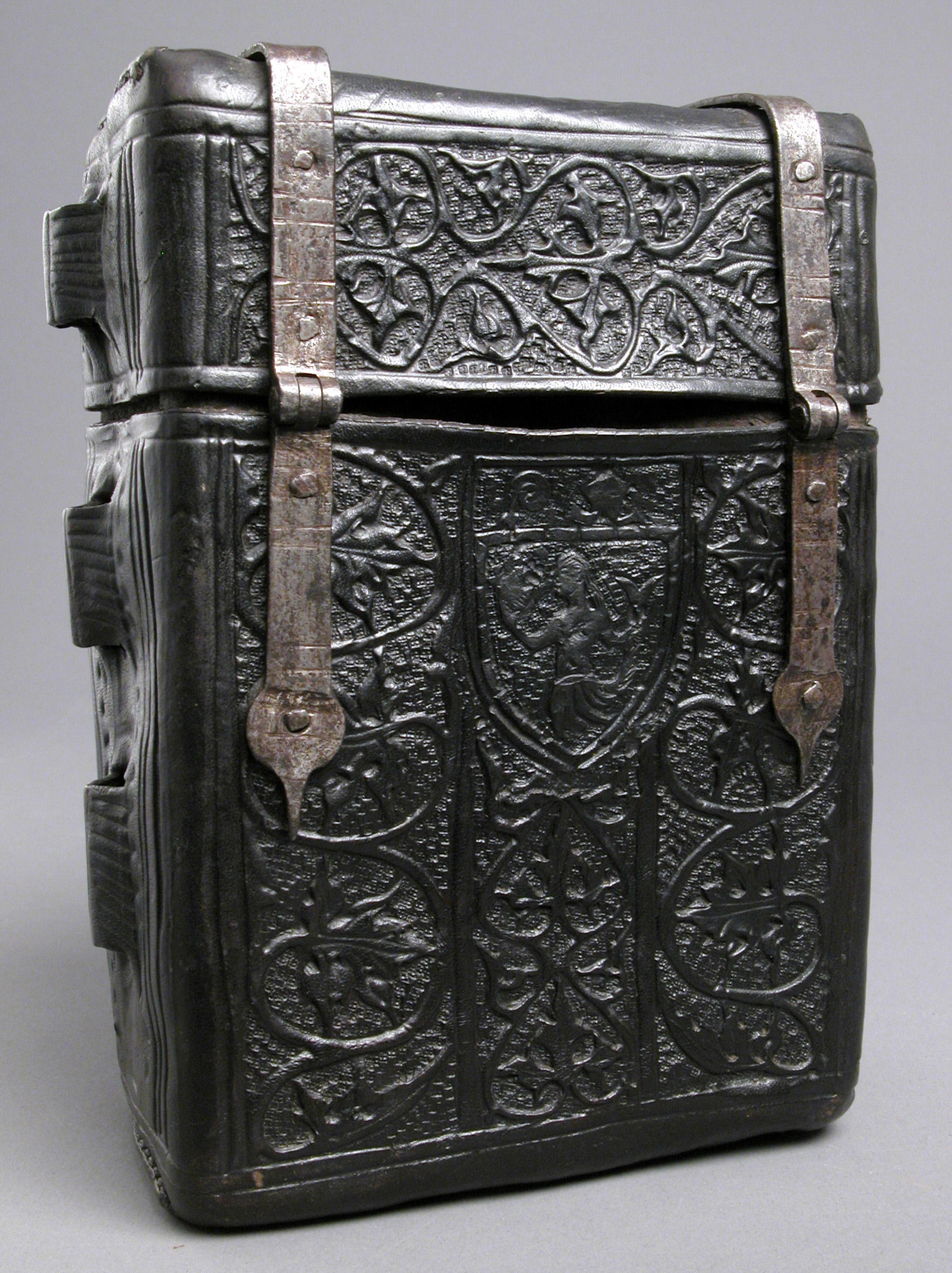|
Shorwell Helmet
The Shorwell helmet is an Anglo-Saxon helmet from the early to mid-sixth century AD found near Shorwell on the Isle of Wight in southern England. It was one of the grave goods of a high-status Anglo-Saxon warrior, and was found with other objects such as a pattern-welded sword and hanging bowl. One of only six known Anglo-Saxon helmets, alongside those found at Benty Grange (1848), Sutton Hoo (1939), Coppergate (1982), Wollaston (1997), and Staffordshire (2009), it is the sole example to derive from the continental Frankish style rather than the contemporaneous Northern "crested helmets" used in England and Scandinavia. The grave was discovered by members of a metal detecting club in May 2004, and excavated by archaeologists that November. Ploughing had destroyed much of the surrounding Anglo-Saxon cemetery, leaving this as the only individually identifiable grave. The helmet had fragmented into around 400 pieces, perhaps in part because of subsoiling, and was original ... [...More Info...] [...Related Items...] OR: [Wikipedia] [Google] [Baidu] |
Iron
Iron () is a chemical element with symbol Fe (from la, ferrum) and atomic number 26. It is a metal that belongs to the first transition series and group 8 of the periodic table. It is, by mass, the most common element on Earth, right in front of oxygen (32.1% and 30.1%, respectively), forming much of Earth's outer and inner core. It is the fourth most common element in the Earth's crust. In its metallic state, iron is rare in the Earth's crust, limited mainly to deposition by meteorites. Iron ores, by contrast, are among the most abundant in the Earth's crust, although extracting usable metal from them requires kilns or furnaces capable of reaching or higher, about higher than that required to smelt copper. Humans started to master that process in Eurasia during the 2nd millennium BCE and the use of iron tools and weapons began to displace copper alloys, in some regions, only around 1200 BCE. That event is considered the transition from the Bronze Age to the Iron A ... [...More Info...] [...Related Items...] OR: [Wikipedia] [Google] [Baidu] |
Excavation (archaeology)
In archaeology, excavation is the exposure, processing and recording of archaeological remains. An excavation site or "dig" is the area being studied. These locations range from one to several areas at a time during a project and can be conducted over a few weeks to several years. Excavation involves the recovery of several types of data from a site. This data includes artifacts (portable objects made or modified by humans), features (non-portable modifications to the site itself such as post molds, burials, and hearths), ecofacts (evidence of human activity through organic remains such as animal bones, pollen, or charcoal), and archaeological context (relationships among the other types of data).Kelly&Thomas (2011). ''Archaeology: down to earth'' (4th ed.). Belmont, Calif.: Wadsworth, Cengage Learning. Before excavating, the presence or absence of archaeological remains can often be suggested by, non-intrusive remote sensing, such as ground-penetrating radar. Basic informat ... [...More Info...] [...Related Items...] OR: [Wikipedia] [Google] [Baidu] |
Vendel
Vendel is a village at Tierp Municipality in Uppland, Sweden. The village overlooks Vendelsjön, a long inland stretch of water near the Vendel river which has its confluence with the river Fyris. Vendel was the site of an ancient royal estate, part of ''Uppsala öd'', a network of royal estates meant to provide income for the medieval Swedish kings. A large number of archaeological finds have been found here, which have given their name to the Vendel Period. Vendel Church (''Vendels kyrka'') was probably begun to be built in Romanesque style during the latter half of the 13th century. Around 1450, the church was vaulted with brick vaults. The church is most noted for its murals by Johannes Iwan who worked in Uppland during the 15th century. Archaeological research In 1881 to 1883, several excavations by Swedish archaeologist Hjalmar Stolpe (1841–1905) revealed 14 graves in and just beyond the south-east corner of the churchyard. Several of the burials were contained in ... [...More Info...] [...Related Items...] OR: [Wikipedia] [Google] [Baidu] |
Beowulf
''Beowulf'' (; ang, Bēowulf ) is an Old English epic poem in the tradition of Germanic heroic legend consisting of 3,182 alliterative lines. It is one of the most important and most often translated works of Old English literature. The date of composition is a matter of contention among scholars; the only certain dating is for the manuscript, which was produced between 975 and 1025. Scholars call the anonymous author the "''Beowulf'' poet". The story is set in pagan Scandinavia in the 6th century. Beowulf, a hero of the Geats, comes to the aid of Hrothgar, the king of the Danes, whose mead hall in Heorot has been under attack by the monster Grendel. After Beowulf slays him, Grendel's mother attacks the hall and is then defeated. Victorious, Beowulf goes home to Geatland and becomes king of the Geats. Fifty years later, Beowulf defeats a dragon, but is mortally wounded in the battle. After his death, his attendants cremate his body and erect a tower on a headland in ... [...More Info...] [...Related Items...] OR: [Wikipedia] [Google] [Baidu] |
Bretzenheim
Bretzenheim is an ''Ortsgemeinde'' – a municipality belonging to a ''Verbandsgemeinde'', a kind of collective municipality – in the Bad Kreuznach district in Rhineland-Palatinate, Germany. It belongs to the ''Verbandsgemeinde'' Langenlonsheim-Stromberg, whose seat is in Langenlonsheim. Bretzenheim is a state-recognized tourism community and a winegrowing centre. It is also one of the district's ten biggest municipalities. Geography Location Bretzenheim lies on the Nahe, 10 km up from its mouth where it empties into the Rhine at Bingen am Rhein to the north. The municipality lies just north of Bad Kreuznach. Neighbouring municipalities Clockwise from the north, Bretzenheim's neighbours are the municipality of Langenlonsheim, the town of Bad Kreuznach and the municipality of Guldental. History It was people of the Linear Pottery culture of the New Stone Age who, about 5000 BC, founded the first settlement of any great size at what is now Bretzenheim. A wealth of arc ... [...More Info...] [...Related Items...] OR: [Wikipedia] [Google] [Baidu] |
Trivières
Trivières ( wa, Triviere) is a village of Wallonia and a district of the municipality of La Louvière, located in the province of Hainaut, Belgium. It is located between Mons and Charleroi, about south of Brussels. It was a fully fledged municipality before the fusion of the Belgian municipalities. It is in size. Etymology The origin of the name Trivières probably derives from the Latin word trivium, meaning three paths. Three roads intersect at the centre of Trivières, one leading east to , one north to Strépy, and one southwest to Estinnes. Three rivers, the Haine, the Princess of Rieu, and the Estinnes, also cross the village. Another, probably legendary, suggested origin of the name is that it derives from the Belgic tribe Treveri, said to have been massacred in the area by the Roman legions of Tiberius and Nero Claudius Drusus. History Trivières dates to at least the Roman era, and has a rich archaeological history. Excavations have uncovered an artificial harb ... [...More Info...] [...Related Items...] OR: [Wikipedia] [Google] [Baidu] |
Late Roman Ridge Helmet
The Late Roman ridge helmet was a type of combat helmet of Late Antiquity used by soldiers of the Late Roman army. It was characterized by the possession of a bowl made up of two or four parts, united by a longitudinal ridge. Origins In the late 3rd century, a complete break in Roman helmet design occurred. Previous Roman helmet types, based ultimately on Celtic designs, were replaced by new forms derived from helmets developed in the Sassanid Empire. A closely related form to the Roman ridge helmets is represented by a single helmet from Dura Europos which is of similar construction, but has a much higher-vaulted skull. It probably belonged to a Sassanid warrior of the 3rd century. This reinforces the evidence for a Sassanid origin of this type of helmet. Two main forms of helmet construction were adopted by the Romans at much the same time: the ridge helmet, described here, and the Spangenhelm, which was likely adopted from the Sarmatians. The earliest confirmed example of a Late ... [...More Info...] [...Related Items...] OR: [Wikipedia] [Google] [Baidu] |
Relief
Relief is a sculptural method in which the sculpted pieces are bonded to a solid background of the same material. The term ''relief'' is from the Latin verb ''relevo'', to raise. To create a sculpture in relief is to give the impression that the sculpted material has been raised above the background plane. When a relief is carved into a flat surface of stone (relief sculpture) or wood (relief carving), the field is actually lowered, leaving the unsculpted areas seeming higher. The approach requires a lot of chiselling away of the background, which takes a long time. On the other hand, a relief saves forming the rear of a subject, and is less fragile and more securely fixed than a sculpture in the round, especially one of a standing figure where the ankles are a potential weak point, particularly in stone. In other materials such as metal, clay, plaster stucco, ceramics or papier-mâché the form can be simply added to or raised up from the background. Monumental bronze reliefs a ... [...More Info...] [...Related Items...] OR: [Wikipedia] [Google] [Baidu] |
Scabbard
A scabbard is a sheath for holding a sword, knife, or other large blade. As well, rifles may be stored in a scabbard by horse riders. Military cavalry and cowboys had scabbards for their saddle ring carbine rifles and Lever action, lever-action rifles on their horses for storage and protection. Scabbards have been made of many materials over the millennia, including leather, wood, and metals such as brass or steel. Most commonly, sword scabbards were worn suspended from a sword belt or shoulder belt called a baldric. Antiquity Wooden scabbards were typically covered in fabric or leather; the leather versions also usually bore metal fittings for added protection and carrying ease. Japanese blades typically have their sharp cutting edge protected by a wooden scabbard called a Japanese sword mountings#Saya, saya. Many scabbards, such as ones the Greeks and Romans used, were small and light. It was designed for holding the sword rather than protecting it. All-metal scabbards were ... [...More Info...] [...Related Items...] OR: [Wikipedia] [Google] [Baidu] |
Cuir Bouilli
Boiled leather, often referred to by its French translation, cuir bouilli (), was a historical material common in the Middle Ages and Early Modern Period and used for various purposes. It was leather that had been treated so that it became tough and rigid, as well as able to hold moulded decoration. It was the usual material for the robust carrying-cases that were made for important pieces of metalwork, instruments such as astrolabes, personal sets of cutlery, books, pens and the like. It was used for some armour, being both much cheaper and much lighter than plate armour, but could not withstand a direct blow from a blade, nor a gunshot. Alternative names are "moulded leather" and "hardened leather". In the course of making the material it becomes very soft, and can be impressed into a mould to give it the desired shape and decoration, which most surviving examples have. Pieces such as chests and coffers also usually have a wooden inner core. Various recipes for making cuir ... [...More Info...] [...Related Items...] OR: [Wikipedia] [Google] [Baidu] |
Dexter And Sinister
''Dexter'' and ''sinister'' are terms used in heraldry to refer to specific locations in an escutcheon bearing a coat of arms, and to the other elements of an achievement. ''Dexter'' (Latin for 'right') indicates the right-hand side of the shield, as regarded by the bearer, i.e. the bearer's proper right, and to the left as seen by the viewer. ''Sinister'' (Latin for 'left') indicates the left-hand side as regarded by the bearer – the bearer's proper left, and to the right as seen by the viewer. In vexillology, the equivalent terms are '' hoist'' and ''fly''. Significance The dexter side is considered the side of greater honour, for example when impaling two arms. Thus, by tradition, a husband's arms occupy the dexter half of his shield, his wife's paternal arms the sinister half. The shield of a bishop shows the arms of his see in the dexter half, his personal arms in the sinister half. King Richard II adopted arms showing the attributed arms of Edward the Confessor in t ... [...More Info...] [...Related Items...] OR: [Wikipedia] [Google] [Baidu] |
Rivet
A rivet is a permanent mechanical fastener. Before being installed, a rivet consists of a smooth cylindrical shaft with a head on one end. The end opposite to the head is called the ''tail''. On installation, the rivet is placed in a punched or drilled hole, and the tail is ''upset'', or ''bucked'' (i.e., deformed), so that it expands to about 1.5 times the original shaft diameter, holding the rivet in place. In other words, the pounding or pulling creates a new "head" on the tail end by smashing the "tail" material flatter, resulting in a rivet that is roughly a dumbbell shape. To distinguish between the two ends of the rivet, the original head is called the ''factory head'' and the deformed end is called the ''shop head'' or buck-tail. Because there is effectively a head on each end of an installed rivet, it can support tension loads. However, it is much more capable of supporting shear loads (loads perpendicular to the axis of the shaft). Fastenings used in traditional w ... [...More Info...] [...Related Items...] OR: [Wikipedia] [Google] [Baidu] |








